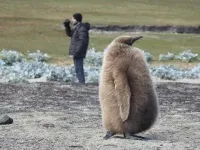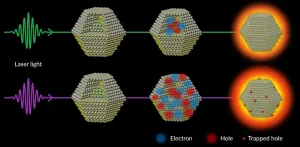New discoveries of deep brain stimulation put it on par with therapeutics
Possibly speeding the process and allowing personalized treatment
2021-03-25
(Press-News.org) Despite having remarkable utility in treating movement disorders such as Parkinson's disease, deep brain stimulation (DBS) has confounded researchers, with a general lack of understanding of why it works at some frequencies and does not at others. Now a University of Houston biomedical engineer is presenting evidence in Nature Communications Biology that electrical stimulation of the brain at higher frequencies (>100Hz) induces resonating waveforms which can successfully recalibrate dysfunctional circuits causing movement symptoms.
"We investigated the modulations in local ?eld potentials induced by electrical stimulation of the subthalamic nucleus (STN) at therapeutic and non-therapeutic frequencies in Parkinson's disease patients undergoing DBS surgery. We ?nd that therapeutic high-frequency stimulation (130-180 Hz) induces high-frequency oscillations (~300 Hz, HFO) similar to those observed with pharmacological treatment," reports Nuri Ince, associate professor of biomedical engineering.
For the past couple of decades, deep brain stimulation (DBS) has been the most important therapeutic advancement in the treatment of Parkinson's disease, a progressive nervous system disorder that affects movement in 10 million people worldwide. In DBS, electrodes are surgically implanted in the deep brain and electrical pulses are delivered at certain rates to control tremors and other disabling motor signs associated with the disease.
Until now, the process to find the correct frequency has been time consuming, with it taking sometimes months to implant devices and test their abilities in patients, in a largely back and forth process. Ince's method may speed the time to almost immediate for the programming of devices at correct frequencies.
"For the first time, we stimulated the brain and while doing that we recorded the response of the brain waves at the same time, and this has been a limitation over the past years. When you stimulate with electrical pulses, they generate large amplitude artifacts, masking the neural response. With our signal processing methods, we were able to get rid of the noise and clean it up," said Ince. "If you know why certain frequencies are working, then you can adjust the stimulation frequencies on a subject-specific basis, making therapy more personalized."
INFORMATION:
DBS is also being explored for the treatment of many other neurological and psychiatric indications, including Obsessive-Compulsive Disorder.
Additional authors of the article are Ince's doctoral student Musa Ozturk; and Ashwin Viswanathan and Sameer Sheth, Baylor College of Medicine.
[Attachments] See images for this press release:

ELSE PRESS RELEASES FROM THIS DATE:
2021-03-25
Tel-Aviv, ISRAEL - March 25, 2021 - Wild Biotech, a preclinical stage drug discovery & development company emerging out of stealth mode, today announces the publication of its first major paper, which appears in the journal Science. The study mapped the gut microbiota of animals in the wild on an unprecedented scale, adding millions of potentially novel microbiome-based therapeutics for human diseases to the company's already massive database. Wild will use these findings to first tap its database for targets in inflammatory, immune and gastrointestinal diseases.
"For the study, we collected gut microbiota from almost 200 species of animals in the wild, covering diverse classes, feeding behaviors, geographies, and ...
2021-03-25
Water scarcity in rural Alaska is not a new problem, but the situation is getting worse with climate change. Lasting solutions must encourage the use of alternative water supplies like rainwater catchment and grey water recycling. They must also address the affordability of water related to household income, say researchers from McGill University.
Washing hands with clean water is something most people take for granted, yet for Alaska's rural residents, this is often not the case. When people pay for water by the gallon, serious thought is given to how much is used - even during the COVID-19 pandemic.
In many rural Alaskan communities, where jobs are scarce and household income is low, the cost of water is a high burden, according to the study published in Environmental ...
2021-03-25
A medical device that has been shown to manage pain among babies born preterm can also help keep their brain oxygen levels steady during medical procedures, finds new analysis by researchers at UBC.
The device, called Calmer, is a pillow-sized therapeutic bed covered in soft fabric and inserted into the incubator. It can be programmed to mimic a parent's heartbeat and breathing rate-- providing a soothing presence by moving up and down gently to simulate a breathing motion and heartbeat sound for the baby when their parent cannot be present.
"For newborns and particularly for preterm babies, it's critical to keep overall blood oxygen levels steady, especially in the brain. The more stable their brain oxygenation is, the better for their brain development," ...
2021-03-25
Researchers at the Georgia Institute of Technology have uncovered an innovative way to tap into the over-capacity of 5G networks, turning them into "a wireless power grid" for powering Internet of Things (IoT) devices that today need batteries to operate.
The Georgia Tech inventors have developed a flexible Rotman lens-based rectifying antenna (rectenna) system capable, for the first time, of millimeter-wave harvesting in the 28-GHz band. (The Rotman lens is key for beamforming networks and is frequently used in radar surveillance systems to see targets in multiple directions without physically moving the antenna system.)
But to harvest enough power to supply low-power devices at long ranges, large aperture antennas are required. The problem with ...
2021-03-25
Researchers at Baylor College of Medicine, Shandong University in China and other institutions may have found an explanation for dawn phenomenon, an abnormal increase of blood sugar only in the morning, observed in many patients with type 2 diabetes. They report in the journal Nature that mice lacking the circadian clock gene called Rev-erb in the brain show characteristics similar to those of dawn phenomenon.
The researchers then looked at Rev-erb gene expression in patients with type 2 diabetes comparing a group with dawn phenomenon to a group without it and found that the gene's expression followed a different temporal pattern between these two groups. The findings support the idea that an altered daily rhythm of expression of the Rev-erb gene may underlie dawn phenomenon. Future ...
2021-03-25
WASHINGTON (March 25, 2021)--Although demand for COVID-19 vaccines currently seems high, vaccine hesitancy could pose a major threat to public health efforts to end the pandemic, according to an editorial published today in the journal Science.
The authors, including David A. Broniatowski, associate director of the George Washington University Institute for Data, Democracy & Politics, point out that public sentiment towards vaccines are volatile in the face of events such as the recent controversy surrounding the AstraZeneca vaccine clinical trial data. For example, some people could develop safety concerns due to the news reporting about the AstraZeneca vaccine and then turn down the chance to ...
2021-03-25
Narcissism is driven by insecurity, and not an inflated sense of self, finds a new study by a team of psychology researchers. Its research, which offers a more detailed understanding of this long-examined phenomenon, may also explain what motivates the self-focused nature of social media activity.
"For a long time, it was unclear why narcissists engage in unpleasant behaviors, such as self-congratulation, as it actually makes others think less of them," explains Pascal Wallisch, a clinical associate professor in New York University's Department of Psychology and the senior author of the paper, which appears in the journal Personality and Individual Differences. "This has become quite prevalent in the age of social media--a behavior that's been coined 'flexing'.
"Our ...
2021-03-25
A study by prof. Bas van Bavel and prof. Marten Scheffer shows that throughout history, most disasters and pandemics have boosted inequality instead of levelling it. Whether such disastrous events function as levellers or not, depends on the distribution of economic wealth and political leverage within a society at the moment of crisis. Their findings on the historical effects of crises on equality in societies are now published open access in Nature HSS Communications.
It is often thought that the main levellers of inequality in societies were natural disasters such as epidemics or earthquakes, and social turmoil such as wars and ...
2021-03-25
CHAMPAIGN, Ill. -- Materials that contain special polymer molecules may someday be able to warn us when they are about to fail, researchers said. Engineers at the University of Illinois Urbana-Champaign have improved their previously developed force-sensitive molecules, called mechanophores, to produce reversible, rapid and vibrant color change when a force is applied.
The new study led by postdoctoral researcher Hai Qian, materials science and engineering professor and head Nancy Sottos, and Beckman Institute of Advanced Science and Technology director Jeffrey Moore is published in the journal Chem.
Moore's team has been working with mechanophores for more than a decade, but past efforts have produced molecules that were slow to react and return to their original state, if at all. ...
2021-03-25
Bright semiconductor nanocrystals known as quantum dots give QLED TV screens their vibrant colors. But attempts to increase the intensity of that light generate heat instead, reducing the dots' light-producing efficiency.
A new study explains why, and the results have broad implications for developing future quantum and photonics technologies where light replaces electrons in computers and fluids in refrigerators, for example.
In a QLED TV screen, dots absorb blue light and turn it into green or red. At the low energies where TV screens operate, this conversion of light from one color to another is virtually 100% efficient. But at the higher excitation energies required for brighter screens and other ...
LAST 30 PRESS RELEASES:
[Press-News.org] New discoveries of deep brain stimulation put it on par with therapeutics
Possibly speeding the process and allowing personalized treatment




